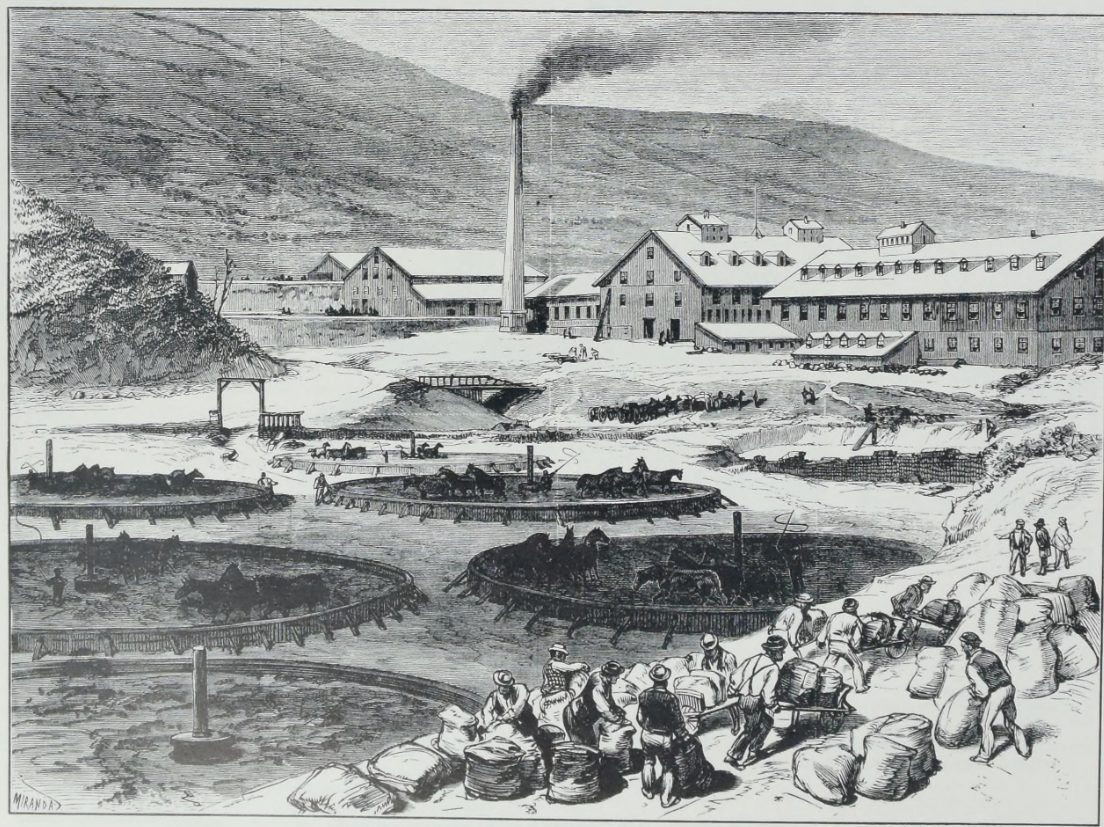The Gould & Curry Silver Mining Company’s heydays were the years 1863-64, just before statehood. Incorporated a few years earlier, the founder of the original claim in the Comstock was Albert Gould, who unwisely sold his share of half the mine for a pittance and died years later and nearly broke in Reno. The mine was, in its peak earning years, the biggest producer of silver ore in the country and one of its namesakes, Abraham Curry, became the first superintendent of the Carson City Mint, which was opened principally to accommodate the huge amounts of silver bullion coming from the Comstock.
There are several what might be called “species” of silver assay ingots bearing the Gould & Curry ethnic. Three of them will be found in Mr. Ford’s collection. The last is typified by the bar illustrated in Dave Bowers’ American Coin Treasures and Hoards (p.275) and in Bowers & Ruddy’s Henry Clifford Sale catalogue (lot 229). Since the Gould & Curry Silver Mining Company was a huge operation for its day and the bars it routinely poured were large and heavy ones, it must therefore be assumed that the following small silver bars bearing the company’s ethnic were made as souvenirs and keepsakes.
In July, 1965 John O. Curtis, then curator of architecture at Old Sturbridge Village in Massachusetts, wrote to Dr. George Miles, curator at the
American Numismatic Society, inquiring about a silver assay bar, asking if Dr. Miles could tell him anything about it. Mr. Ford learned about the bar through Hillel Kaslov at the A.N.S. and wrote Curtis late that month asking if the bar could be shipped to him for photography and offering to buy it. Curtis replied early in August that the bar was actually owned by William Warren, the chief curator at Old GOULD & CURRY SILVER MINING COMPANY GOULD & CURRY ASSAY OFFICE Virginia City, Nevada Sturbridge Village, and stated that he thought Warren actually owned two such ingots.
At the same time, Warren wrote Ford saying the bars he owned had come from his father and that they were not for sale. By late September Warren had decided to send one of the ingots to Ford for photography and it arrived on September 21, 1965. Warren’s ingot was the Gould & Curry bar number 8280. Ford returned it to Warren on November 19 the same year (Ford subsequently bought the bar on April 11, 1966). In the course of their correspondence, Warren told Ford that Warren’s nephew, Richard Warren, Jr., owned the other bar Curtis had mentioned, another Gould & Curry ingot, this one bar number 2. On expressing his interest in photographing that ingot, as well, William Warren sent the second bar to Ford on January 17, 1966. Ford returned it 10 days later and bought it on March 23, 1966.
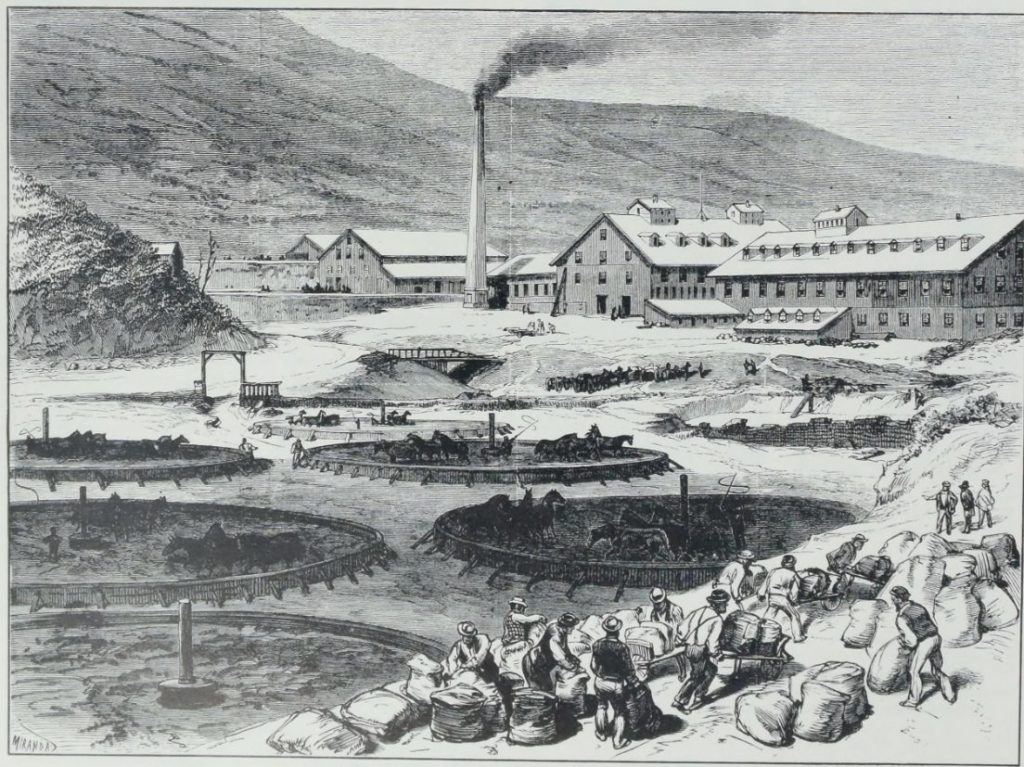
THE GOULD & CURRY MILL—” DESILVERIZING ” THE ORE BY THE PATIO PROCESS.
The two Warren family Gould & Curry ingots are very dissimilar in appearance, as will be seen from the illustrations and descriptions to follow, yet two of their three physical measurements are quite similar. Bar number 2 seems crude compared to bar number 8280 and some of the markings on it defy
easy explanation. If it were only the second silver bar made by the company, its crudity may be explained by the inexperience of its makers. Bar number 8280, by contrast, is a finished product of an experienced and capable assay office. The third Gould & Curry ingot in the Ford Collection was obtained from a New Hampshire dealer in 1977, who claimed he got it from a family resident in California in the 1930s. It is entirely unlike the two Warren bars in size, shape, and finish, but it does share the same ethnic logotype as found on ingot number 2.
14.85 oz Gould & Curry Silver Mining Company. Virginia City, Nevada. Silver & gold assay ingot number 2.
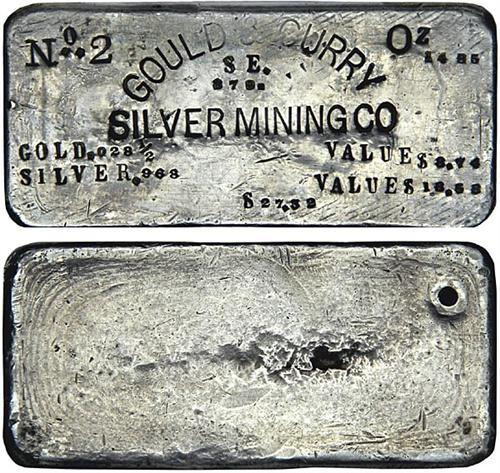
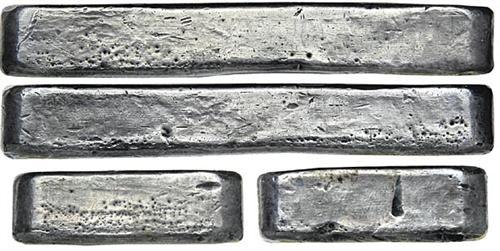
Overall appearance of Very Fine. Light silver gray color, the bar was obviously cleaned before it was sent to Mr. Ford. Somewhat rough in places, file marks visible along portions of the long sides on the face of the bar, puddling marks on the back. Corners rounded, sides finished, the bar looks more like it was made as a souvenir than as a transport or monetary ingot. Test mark in upper right corner on back. Ethnic (maker’s name) in the same logotype to be seen on ingot number 10 later but all other inscriptions on this bar effected through individual numeral and letter punches. The meanings of “S.E./879.” in center on the face are obscure to the cataloguer.
- Face: At upper left, No**2, at upper right, Oz / 1485, GOULD & CURRY above S.E. 879*, SILVER MINING CO / below to left GOLD.028 1/2 / SILVER.968, below to right VALUE $8.74 / VALUE $18.58 / at bottom nearly centered $27.32.
- Back: blank.
- Top side: blank.
- Bottom side: blank.
- Left side: blank.
- Right side: blank.
- Dimensions: 87.1 x 40.8 x 12.7 mm.
- Stated weight: 14.85 ozs.
In a letter dated 12/28/1965 addressed to John Ford at New Netherlands Coin Company on the stationery of Old Sturbridge Village, Sturbridge, Massachusetts and signed William L. Warren, Chief Curator, Warren states: “Here is a xerox of the other ingot. I went into Boston before Christmas and my nephew found the ingot and we both forgot about it. He went to New Haven for Christmas and when he brought his family up to my home in Litchfield last Sunday, brought his ingot. So, if after looking at the ingot, you think it important enough to photograph, I shall send it to you. No one else in the family remembers these ingots or how my father acquired them. I feel pretty sure that his cousin Edwin Tomlinson from Quaker Farms, Connecticut gave them to father. Mr. Tomlinson left Connecticut right after the Civil War and traveled all during his adult life.
He went all over the West investing in mining companies and actually mining himself in the northwest and Canada. He spent some time in California and Alaska, panning for gold and I have samples of gold nuggets and sand. The two largest Alaskan gold nuggets are at the Peabody Museum, New Haven.” A subsequent letter dated 2/18/1966 addressed to John Ford at Rockville Center, N.Y. on the stationery of The Stowe-Day Foundation, Hartford, Connecticut and signed by William Warren states: “Your letter of Jan.28th. I have sent on to my nephew asking whether he wants to sell his ingot. Recently, I ran across a memo my father wrote in 1949 in which he lists the family silver.
The ingots were on the list and he made no mention of where they came from or how they came into his possession. So I may have assumed incorrectly about Edwin Tomlinson giving them to my father. Neither of my brothers knew anything about them, ‘though they remembered the ingots. Museums have so much material that all of it can’t be displayed. They need more storage room than display space. If it is a big collection you have, it is better to have only parts of it showing at any one time. Exhibits get static and it is better to change things and move them around. By doing so, the curators remember the artifacts and freshen their minds and the exhibits.” A final letter accompanying this lot, dated 3/23/1966 addressed to William Warren at The Stowe-Day Foundation on Mr. Ford’s personal Rockville Center letterhead stationery, states:
“Many thanks for your letter which arrived while I was traveling throughout the West on a combination business and pleasure trip. Actually, I broke my left hand early last month, and soon found my left arm (up to the elbow) in plaster. Accordingly, I could not type (my bread and butter), and decided to `go on the road’. Among other places, I visited the Arizona Pioneers Historical Society in Tucson. There, I found employed the `rotating display’ concept you so aptly described in your letter. As you can see by the enclosed copy of my letter to your nephew, I have sent him my check for $300. in payment for his Gould & Curry ingot. Just as soon as he lets you know that he has the check alright, I would appreciate your sending the piece down to me. The offer in my letter of January 28th is still valid. If you want to send me your Gould & Curry ingot, I will send you my check in the amount of $450. I will leave your earlier data re Edwin Tomlinson (and the ingots) in my files, but will note your new information as given in your last letter.”
From the John J. Ford, Jr. Collection
Provenance: From Richard Warren, Jr. on March 23, 1966.
[10/2007] https://auctions.stacksbowers.com/lots/view/3-AV6M1/gould-curry-silver-mining-company-virginia-city-nevada-silver-gold-assay-ingot-number-2 ($27,600)
Measures 3 3/8″ x 1 9/16″ x 1/2″. The reverse and sides are all unmarked. The G & C bullion punch matches the style of the punch held by the Keck (Mackay) Museum in Reno, given them by the descendants of the Con Virginia MC, probably prior to 1940 (Fulton collected much material from key Comstockers before 1929). No assay chip, but there is a drill hole in the upper right corner of the reverse where an assay was taken.
The rounded corners of this ingot, and its general style of manufacture have always led me to believe the ingot is a product of post-bonanza production, certainly post-1890, which took advantage of the new cyanide extraction process for lower valued ores.
After much research, it is believed that the ingot was produced in 1904, in conjunction with a major new mining effort and a reincorporation of the company in San Francisco, California, where its head office was located. The ratio of gold to silver was typical of Comstock mines.
Provenance
This Gould & Curry Silver Mining Co. silver ingot is x-Ford, Part XXI, lot 3514 ($27,600). The original documentation of Ford, complete with letters, comes with the ingot.
Ford purchased the ingot from the family of William L. Warren, Curator, Old Sturbridge Village Museum, Sturbridge, Massachusetts in 1966. The letter states that Warren’s father was given the ingots from his cousin Edwin Tomlinson of Quaker Farms, Connecticut. Tomlinson was an active mining investor, prospector, and traveler. His biography states “he (made) a fortune in the mining and oil business between 1874 and 1897.” The letter mentions another ingot and gold nuggets, the whereabouts of which are unknown today.
Background – 1860’s History
The Gould & Curry is unarguably one of the most important mines on the Comstock, and also is solely responsible for the huge gains in Comstock mine stock prices in 1863 that made millionaires overnight of many mining men (stock quoted in July, 1863 at $6,300 per foot). George Hearst was one of the men who helped consolidate the Alva Gould and Abe Curry (First Superintendent of the Carson City Mint) claims into the Gould & Curry. He and partners John Earl and William Lent and others went on to incorporate the G&C, ultimately making them millions. Inflated stock prices in 1863 later caused a massive market crash, because investors couldn’t tell the legitimate mines from the promotions and development efforts of the outright frauds (ex: Fly By Night Gold and Silver MC). G&C stock fell to $900 per foot by July, 1864. The Gould & Curry built the largest mill in America in 1863, only to nearly run out of ore within a year. The superintendent, Charles Strong, ultimately committed suicide after all of his mining investments failed.
The mine produced just under $16 million before 1889. It is entirely possible that half of this came before 1864, though records are poor. As a visual reference, a significant portion of the men listed in Kelly’s 1863 Territorial Directory were employed by the G&C MC.
Post-1885 History
Much is written on the Comstock from the discovery through the Hale & Norcross Bonanza of the mid-1880’s. But little summary work has ever been published on the post-1885 period, particularly post-1890. With production during that period at nearly nine million ounces of gold and 220 million ounces of silver, it is no wonder it has been generally left out of the modern historical record. However, a careful search of the Mining and Scientific Press and Engineering and Mining Journal, accompanied by the Mines Handbook, gives us a much better picture of the “new era” of mining on the Comstock.
In summary, the mines of the middle and north end of the Comstock were generally flooded below the Sutro Tunnel Level since about 1880-1885. Mining on the Comstock was basically dead during the depression of the early 1890’s, a great part due to the flooding of the deep levels. Annual production during that decade was at an all-time low of under $1,000,000 per year (1895-1910).
In 1897, the G&C had begun to experiment with low grade ore, averaging about $12 per ton. By November of that year, reports had confirmed the grade. The experiment was for 1000 tons. But it was unsuccessful, and by the end of 1899, the company only had $468 in the bank and owed another $4,000. Many of the mines were in a similar position. The group of northern and middle mines got together in about 1902 and put together a plan to pump the lower levels to access what they thought would be more ore. The plan included revamping the Ward Shaft and accessing all of the mines of these groups through the Ward Shaft. The shaft, which was caved, a mess and inoperative in 1902, was completely revamped by 1904. By April, it was pumping full force. Additionally, with renewed interest and access to ores not accessible in 25 years, the Butters Mill, using the new, more efficient cyanide process, was reopened as were several other mills.
The G&C SMC, taking advantage of the new operations, reincorporated in 1904 to sell more stock to pay for their portion of the Ward, and for exploration activity. It represented a new day for the G&C. It was at this time, I believe, that the ingot was issued and used as a marketing tool in San Francisco, or at a shareholder meeting in December, 1904. The serial number of #2 is very indicative of a new beginning, and very typical of ingot numbering.
It ultimately took years for the mines of the north and middle ends to get going. The pumping was slow, as was mine cleanup, sampling and drilling. After 1915, production on the Comstock again rose to over $1 million per year.
This unique ingot is a choice example of a Comstock mine ingot.
[06/2023] https://holabirdamericana.liveauctiongroup.com/Gould-Curry-Silver-Mining-Company-Ingot-Virginia-City-Nevada-165231_i49117387 ($24,375)
[08/2014] https://holabirdamericana.liveauctiongroup.com/Gould-Curry-Ingot_i20352920
22.2 oz Gould & Curry Silver Mining Company. Virginia City, Nevada. Silver assay ingot number 10.
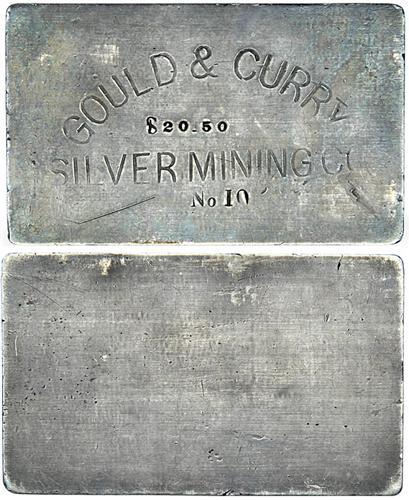
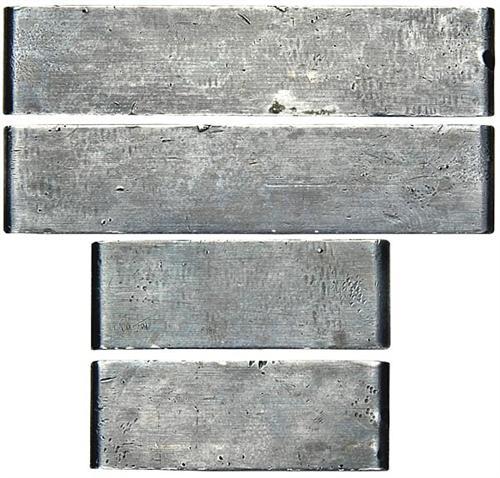
Overall appearance of Fine due principally to light impressions from the punches. Nice, rich silver gray color. An exceptionally well formed bar with sharp edges, lightly rounded corners, fully finished faces. Test cut in the center of one short edge. This was not meant to be melted or be shipped away for commercial purposes. Rather, the bar has the physical appearance of a souvenir, keepsake, or other special purpose. Its lack of fineness, weight, or even an indication of its contents shows it would not have been suitable for commerce. The ethnic is the same seen on bar number 2, above. The stamps for the bar’s dollar value and ingot number were done after the ethnic stamp had been applied. Mr. Ford wrote on his collection card “A neatly finished ingot, apparently made for experimental or presentation purposes.”
Face: GOULD & CURRY above $20.50, SILVER MINING CO above No 10.
- Back: blank.
- Top side: blank.
- Bottom side: blank.
- Left side: blank.
- Right side: blank.
- Dimensions: 87.1 x 40.8 x 12.7 mm.
- Stated weight: 22.2 ozs.
From the John J. Ford, Jr. Collection
Provenance: Ex John Hunter, North-East Coin Company (Hillsboro, NH) at the American Numismatic Association Convention in New York City on August 25, 1977. Said by Hunter to have been ex Californian Henry B. Phillips.
[10/2007] https://auctions.stacksbowers.com/lots/view/3-AV6M7/gould-curry-silver-mining-company-virginia-city-nevada-silver-assay-ingot-number-10 ($25,300)
16.51 oz ND. Gould & Curry Silver Mining Co. (Virginia City, Nev.) Gold & silver refined assay bar, #875
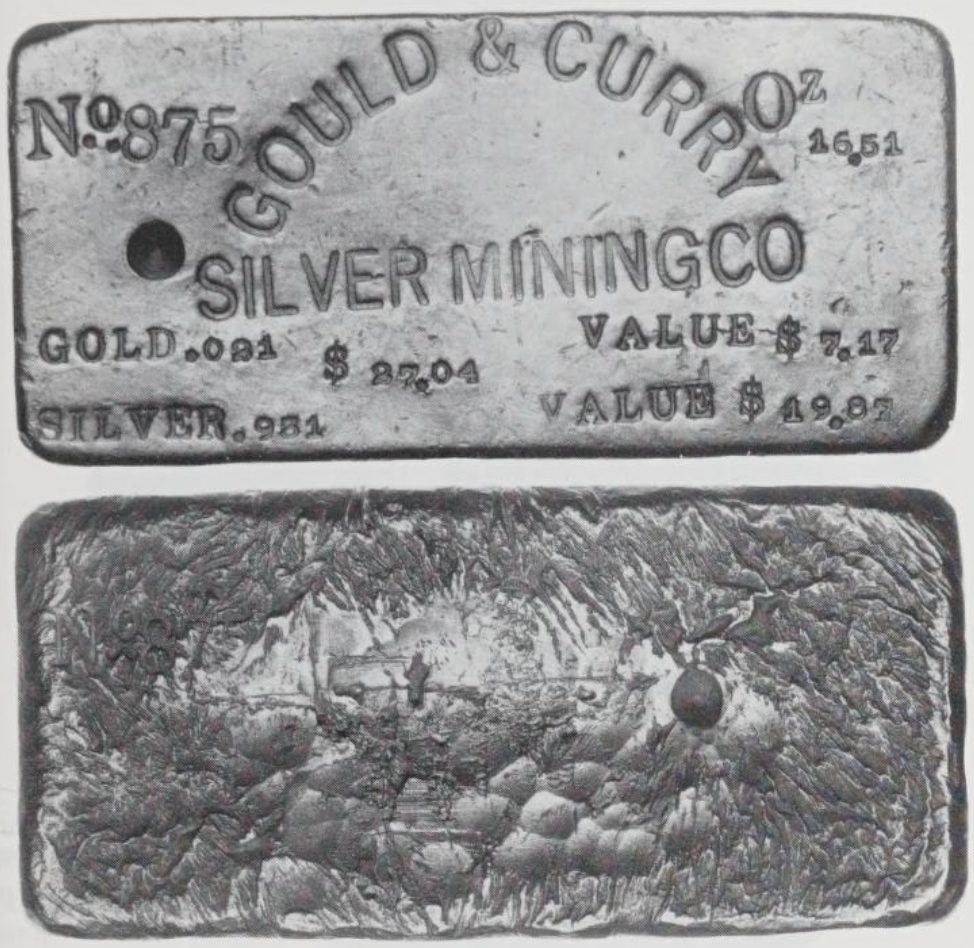
83×39 x 16mm. 16.51 Ozs. (7929.60 grains). Gold .021 Fine, Silver .931 Fine; Gold $7.17, Silver $19.87 (total $27.04). (Photo) ($4,000-Up)
Excavated with the aid of a metal detector in the basement of a Virginia City, Nevada, house (the Comstock Lode area). Purchased in luly, 1972 In/ John /. Ford, Jr.; sold to Hanson, 813/73; sold by Hanson to our present consignor 2/77, at the N.A.S.C. Convention, Los Angeles. “No. 875” punched into upper left reverse as well as on obverse.
[04/1980] https://nnp.wustl.edu/library/auctionlots?AucCoId=511370&AuctionId=521430
15.03 oz Nevada. Undated (ca. 1860-1866) Gould & Curry Silver Mining Company. $23.84 Mixed Metal Ingot
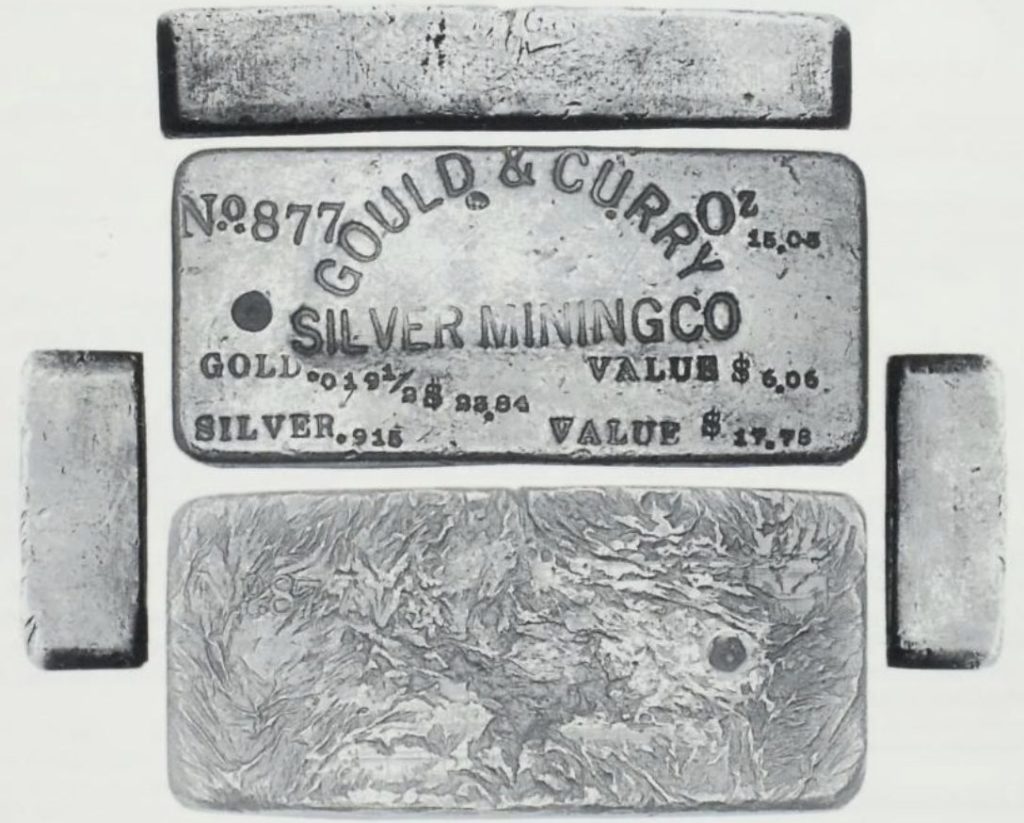
Extremely Fine, two small conical depressions from later assay drill tests. Uniface rectangular mixed metal ingot, inscriptions on the uppermost face, only, accomplished in a combination of prepared and individual punches, and reading: No. 877 / OZ 15.03 / GOULD & CURRY / SILVER MINING CO / GOLD .019‘/2 VALUE $6.06 / $23.84 (the combined values of the gold and silver in the bar) / SILVER .915 VALUE $17.78. Four edges and back blank. Very rare: only eight Gould & Curry ingots were discovered in 1972, underneath what had been the floor of a Virginia City saloon. All of them, including this piece, were unparted ingots.
[06/1997] https://nnp.wustl.edu/library/auctionlots?AucCoId=3&AuctionId=516717
25.6 oz Gould & Curry Assay Office. Virginia City, Nevada. Silver & gold assay ingot no. 8280.
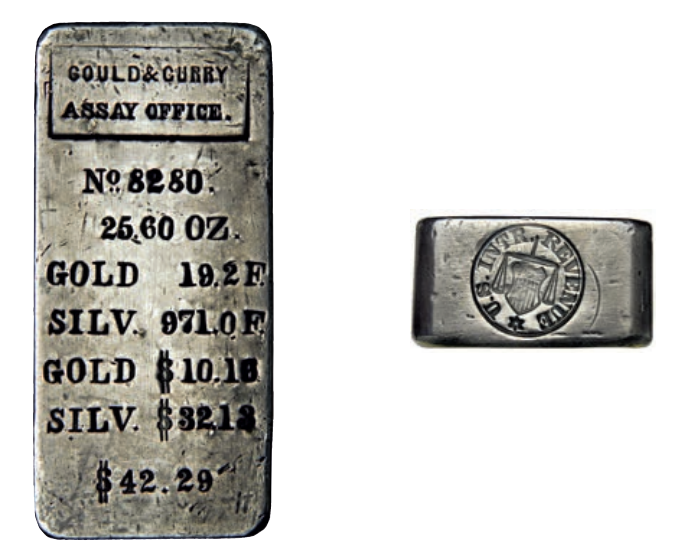
Overall appearance of Very Fine. A handsome ingot with rich silver gray color, good shape, and a very solid heft in the hand. Clearly made to be saved, with finished face and sides, rounded corners, properly entered inscriptions, and the cooling depression on the back finished off. Some light roughness on the face. The Gould & Curry Assay Office was attached to the Gould & Curry Silver Mining Company as an assaying arm of the bigger firm but one that could also do business with private persons. The physical dimensions of this and the preceding bar are quite similar save in their thicknesses. The Office of Internal Revenue stamp was first punched in too low and to the right. It was corrected with better centering and then re-punched over the second try probably to be sure the impression took in the metal.
This ingot was illustrated in the cataloguer’s 1999 AJN II article (see Bibliography).
- Face: In logotype within a square outline GOULD & CURRY / ASSAY OFFICE above No. 8280 / 25.60 OZ. / GOLD 19.2F. / SILV. 971.0F. / GOLD $10.16 / SILV. $32.13 / $42.29.
- Back: blank.
- Top side: blank.
- Bottom side: OIR stamp punched three times.
- Left side: blank.
- Right side: blank.
- Dimensions: 87.2 x 40.8 x 22.1 mm.
- Stated weight: 25.60 ozs.
Ex William L. Warren on April 11, 1966. Mr. Ford’s informational card, Rankow photographs, and 1965 ANS photographs
accompany the lot.
STOLEN
Shortly before this catalogue went to press, this and four other ingots from the Ford Collection were stolen during transit. Since they had already been photographed and described, Stack’s decided to retain their lot descriptions in this catalog in order to preserve their numismatic evidence for future researchers and to aid in their hoped recovery.

